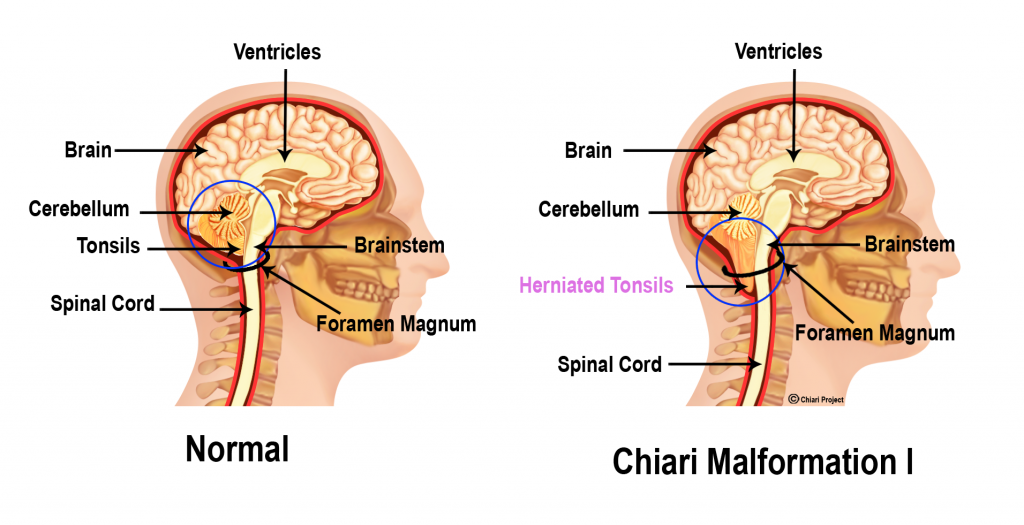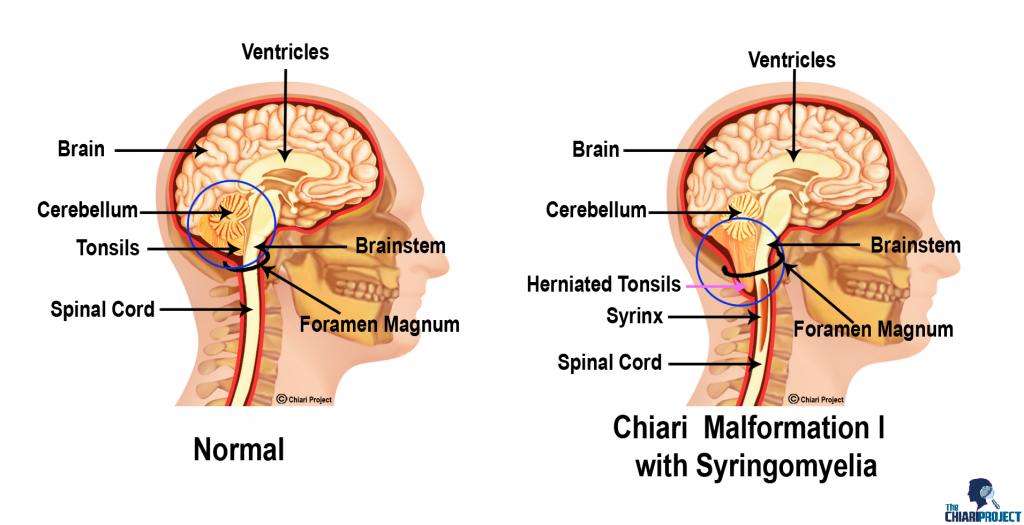WHAT IS CHIARI?

Chiari (pronounced key-are-ee) Malformation is a brain abnormality that causes the cerebellum, the part of the brain that controls coordination and muscle movement, to protrude into the space normally occupied by the spinal cord. Chiari malformation sometimes happens because the space at the back of the skull, where the cerebellum sits above the spine, is too small or is unusually shaped.
The pressure caused by Chiari malformation on the cerebellum, brain stem, and spinal cord can keep them from working correctly. It can also block the movement of cerebrospinal fluid (CSF), the liquid that surrounds the brain and spinal cord and protects them from injury. When CSF doesn’t flow properly, it can build up in the brain and spinal cord and block communication of the brain’s messages to the body and lead to the following symptoms.
SYMPTOMS
- Headaches aggravated by coughing, sneezing, bending over, or getting up suddenly
- Tinnitus
- Vertigo
- Nausea
- Irregular eye movements
- Facial pain
- Muscle weakness
- Impaired gag reflex
- Difficulty Swallowing
- Restless leg syndrome
- Sleep apnea
WHAT IS SYRINGOMYELIA

Syringomyelia (sih-ring-go-my-E-lee-uh) is the development of a fluid-filled cyst (syrinx) within your spinal cord. Over time, the cyst may enlarge, damaging your spinal cord and causing pain, weakness and stiffness, among other symptoms. Syringomyelia has several possible causes, though the majority of cases are associated with a condition in which brain tissue protrudes into your spinal canal (Chiari malformation).
Other causes of syringomyelia include spinal cord tumors, spinal cord injuries and damage caused by inflammation around your spinal cord. If syringomyelia isn’t causing any problems, monitoring the condition may be all that’s necessary. But if you’re bothered by symptoms, you may need surgery.
Syringomyelia symptoms usually develop slowly over time. If your syringomyelia is caused by protrusion of brain tissue into your spinal canal (Chiari malformation), symptoms generally may begin between ages 25 and 40.
SYRINGOMYELIA SYMPTOMS
- Muscle weakness and wasting (atrophy)
- Loss of reflexes
- Loss of sensitivity to pain and temperature
- Stiffness in your back, shoulders, arms and legs
- Pain in your neck, arms and back
- Bowel and bladder function problems
- Muscle weakness and spasms in your legs
- Facial pain or numbness
DIAGNOSING CHIARI MALFORMATION
Chiari malformations can be difficult to diagnose, but a definitive diagnosis is generally made after an MRI scan, where the abnormal protrusion of the cerebellum toward the spinal cord can be seen. In some cases, the diagnosis may be incidental, meaning that a patient who undergoes an MRI scan for another reason may be diagnosed with Chiari when the scan reveals the abnormality – in these cases the patient may not have experienced any symptoms at all.
Anyone who receives a tentative diagnosis of Chiari should always be referred to a neurosurgeon, who will conduct an evaluation and recommend a course of treatment. In addition to an MRI scan of the brain, an MRI of the entire spinal column is useful. In some patients with Chiari, a cyst (known as a syrinx or syringomyelia), forms within the spinal column. Symptoms of leg numbness or scoliosis are more likely when a syrinx exists. (CLICK FOR MORE INFO)
TREATING CHIARI MALFORMATION
One way of treating is Posterior fossa decompression surgery involves the removal of a small portion of the bottom of the skull and sometimes part of the spinal column to correct the irregular bony structure. The surgeon also may open and widen the dura. That’s the firm covering of the brain and spinal cord tissues. This creates additional space for the cerebrospinal fluid to circulate. (CLICK FOR MORE)
